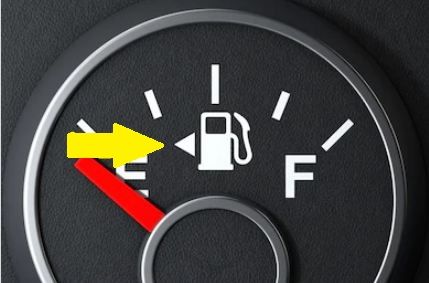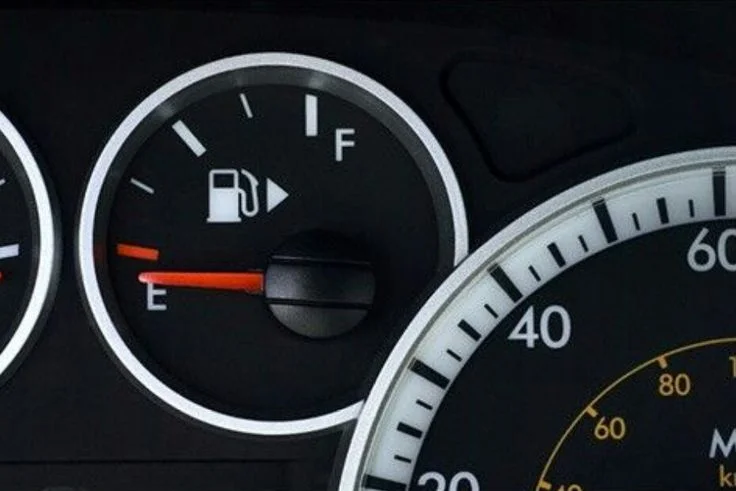It's been hiding in plain sight all along. Nine out of ten drivers have no idea what that tiny arrow means. According to automotive industry experts and AAA Mid-Atlantic, this simple dashboard symbol has been quietly saving motorists from embarrassment and frustration for decades, yet most car owners remain completely oblivious to its purpose.
Picture this: You're driving a rental car in an unfamiliar city. The fuel light blinks on. You pull into a gas station, park confidently on the left side of the pump, step out, and... there's no fuel cap. You walk around the car like a confused tourist, checking every panel. Sound familiar?
This exact scenario happened to Ford designer Jim Moylan on a rainy day in April 1986, and his frustration sparked what would become one of the automotive industry's most brilliant yet overlooked innovations.
The Moylan Arrow
Moylan was filling up a company Ford when Mother Nature decided to test his patience. He pulled up to the wrong side of the pump and got thoroughly soaked walking around the vehicle in the downpour. "I know my car better than this!" he probably muttered, but the truth is, even automotive professionals can forget which side houses the fuel filler on unfamiliar vehicles.
Back at Ford, Moylan wrote a memo to his supervisors proposing a simple solution: add a small arrow next to the fuel gauge pointing toward the fuel filler location. The idea was so elegantly simple and cost-effective that Ford executives immediately saw its value. By 1989, the Ford Escort and Mercury Tracer became the first production vehicles featuring this now-ubiquitous dashboard element.
The feature is now known in automotive circles as the "Moylan Arrow" a fitting tribute to its creator.
How It Actually Works
The system couldn't be more straightforward. Look at your fuel gauge right now. See that tiny triangular arrow next to the gas pump icon? If it points right, your fuel cap is on the passenger side. Points left? Driver's side it is. Some older vehicles use the position of the pump handle in the icon instead - the handle points toward the fuel filler side.
This isn't automotive trivia for show offs. It's practical knowledge that prevents real problems. Ask any rental car agency, and they'll tell you stories about customers calling because they "can't find the gas cap." As one mechanic told me, “People spend five minutes walking around their car like they're inspecting it for purchase, when the answer is right there on the dashboard.”
The Safety Factor You Never Considered
Here's something that might surprise you: fuel cap placement isn't random. Many manufacturers deliberately position fuel fillers on the passenger side for safety reasons. If you run out of gas on a highway and need to refuel from a container, you're adding fuel from the side facing away from traffic, significantly reducing your risk of being struck by passing vehicles.
This safety consideration varies by manufacturer and model, but it demonstrates how much thought goes into seemingly simple design decisions. European manufacturers often place fuel fillers on the right side (passenger side in right hand traffic countries) following this safety principle.
Why This Small Detail Matters More Than You Think
The Moylan Arrow represents something bigger than convenience, it's user-centered design at its finest. Moylan didn't create a complex solution requiring new technology or expensive components. He identified a universal problem and solved it with existing dashboard real estate and a tiny graphic element.
"This car knows exactly what I need!" This is what good design should make you feel, even if you don't consciously notice it. The arrow eliminates guesswork, reduces fuel station awkwardness, and saves time. It's the automotive equivalent of putting handles on the correct side of doors.
The Historical Controversy
While Moylan receives credit for the modern fuel arrow, automotive historians point to an interesting predecessor. Mercedes Benz used a triangular low-fuel warning light on their 1976 W123 models that pointed toward the fuel filler location. However, Mercedes themselves seem to have forgotten this innovation, claiming they first used fuel direction arrows in 1997.
Whether Mercedes had the idea first or not, Moylan's implementation proved more influential and practical. His simple printed arrow became the industry standard that virtually every manufacturer now uses.
What This Means For You
Next time you're in an unfamiliar vehicle, resist the urge to guess which side the fuel cap is on. "I'll figure it out when I get there" is exactly the thinking that leads to gas station shuffle. Take two seconds to check the dashboard arrow before you drive to the pump.
For those buying used cars or considering rentals, this knowledge becomes even more valuable. You can confidently approach any gas station knowing exactly which side to use. It's a small confidence boost that makes driving any vehicle feel more familiar.
The Moylan Arrow proves that the best innovations often solve everyday problems we didn't realize we had. Sometimes the most brilliant solutions are hiding in plain sight, waiting for us to simply pay attention.


Comments (0)
Please login to join the discussion
Be the first to comment on this article!
Share your thoughts and start the discussion